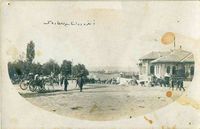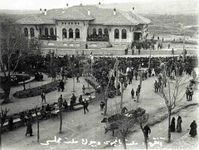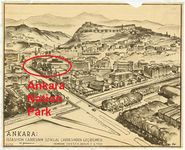Ankara Park - Turkey: Difference between revisions
No edit summary |
|||
| (30 intermediate revisions by the same user not shown) | |||
| Line 2: | Line 2: | ||
>>>''' | >>>'''[[Ankara's First Public Park]]''' | ||
{| align="right" width="300pt" style="background:Gainsboro; color:black" | {| align="right" width="300pt" style="background:Gainsboro; color:black" | ||
| Line 18: | Line 18: | ||
| colspan="3" align="center" style="background:silver"| | | colspan="3" align="center" style="background:silver"| | ||
[[File: | [[File:Arkun Ali Ankara Park 1920.jpg|300px]] | ||
|- | |- | ||
| ||style="background:Lavender"| | | ||style="background:Lavender"| | ||
| Line 27: | Line 27: | ||
|lat=39.940855 | |lat=39.940855 | ||
|lng=32.854103 | |lng=32.854103 | ||
|zoom= | |zoom=12 | ||
|centermarker=yes | |centermarker=yes | ||
|maptypecontrol=yes | |maptypecontrol=yes | ||
| Line 37: | Line 37: | ||
==Why is this case relevant?== | ==Why is this case relevant?== | ||
'''The capital of Turkey''', Ankara forms an integral part of the historic and cultural fabric of Turkey. | '''The capital of Turkey''', Ankara forms an integral part of the historic and cultural fabric of Turkey. Gardens and parks are essential parts of cities. | ||
Gardens and parks are essential parts of cities | |||
Ankara which was a small Anatolian town with an organic urban fabric around the historic castle, had a population of 75000 (Today population is nearly 5.500.000). Ankara has very rich history. It was home to many east and west civilizations such as ''Hittites, Phrygians, Lydians, Persians, Macedonians, Galatians, Romans, Byzantines, Seljuks, and Ottomans'' (Erdogan vd. 2007). | |||
'''Ankara Nation Park''' which was built in early 1900s, could be considered as the first public of new Turkish Republic and important heritage site. The park was opened across '''The Grand National Assembly of Turkey'''. The Grand National Assembly of Turkey is a visually striking landmark and symbol of independence, nation and stability. Ankara Park was built across the The Grand National Assembly and became part of it. It is the first public park of Ankara. | |||
The park site which is also called Ulus Square contribute identity, a sense of time and place to the understanding of park's vicinity as a whole. | |||
This heritage site has historical, cultural, aesthetic, social and scientific values. Besides the heritage value of the park is embodied in its spatial configurations, uses and cultural associations. | This heritage site has historical, cultural, aesthetic, social and scientific values. Besides the heritage value of the park is embodied in its spatial configurations, uses and cultural associations. | ||
In order to identify the Ankara Park which has particular historic significance, explanatory research could be conducted | Historic park is a fragile and finite resource. In order to identify the Ankara Park which has particular historic significance, explanatory research could be conducted. | ||
==Which idea of ‘design with nature’ guides the design concept of this site?== | ==Which idea of ‘design with nature’ guides the design concept of this site?== | ||
A looser, irregular style was used instead of of formal, symmetrical design. | The park were designed to look natural and was a open and green space for relaxation and cultural events. A looser, irregular style was used instead of of formal, symmetrical design. The design tried to bring a sense of nature into urban context. | ||
The park site was completely demolished in early 1960s. The park was very well maintained because it was used for Parliament members, foreign guests and citizens. | |||
If maintenance is missing hard and soft landscape can deteriorate over time. | If maintenance is missing hard and soft landscape can deteriorate over time. | ||
== Which challenges is this landscape facing?== | == Which challenges is this landscape facing?== | ||
Uneven urbanization in Ankara destroyed | Uneven urbanization in Ankara destroyed the park. | ||
The park was demolished in early 1960s for a building complex. | The park was demolished in early 1960s for a building complex. | ||
This building complex is called 100.Yıl Çarşısı. | This building complex is called 100.Yıl Çarşısı. | ||
A six storey office block and four storey (including 2 Basement floor) shopping center was built. | |||
The existing building complex which was built in 1960s, is going to be demolished according to pedestrianization and revitalization project of ULUS Square. The park can be rebuilt again if the building complex will be demolished. | The existing building complex which was built in 1960s, is going to be demolished according to pedestrianization and revitalization project of ULUS Square. The park can be rebuilt again if the building complex will be demolished. | ||
== Gallery== | == Gallery== | ||
<gallery caption=" " widths="200px" heights="150px" perrow="4"> | <gallery caption=" " widths="200px" heights="150px" perrow="4"> | ||
File:Arkun Ali Ankara Park | File:Arkun Ali Ankara Park Flag.jpg | Turkey National Flag | ||
File:Arkun Ali | File:Arkun Ali 17 19 yy map.jpg | Map of Ankara in 1600s, 1800s and early 1900s | ||
File:Arkun Ali Ankara Park 1900s.jpg | Park Site in early 1900s | |||
File:1915s ulus.jpg | Park's main entrance and Parliament Building in early 1920 | |||
File:1920s park ankara.jpg | Park and Parliament Building in early 1920s | |||
File:Arkun Ali Ankara Park 1930s.jpg | Park in late 1930s | |||
File:Arkun Ali park 1930S.jpg | Park Site in Prof.Jansen's Ankara Plan 1930s | |||
File:Arkun Ali Ankara Park 1935.jpg | Park Site in Prof.Jansen's Drawing in 1935 | |||
File:Arkun Ali Pak 1940s.jpg | Park, Ulus Square, The Grand National Assembly and Statue of Victory in 1940s | |||
File:Arkun Ali Ankara Park 1942.JPG | Aerial View of the Park in 1942 | |||
File:Arkun Ali Ankara Park 1940s.jpg | Aerial View of the Park in 1940s | |||
File:Arkun Ali Ankara Park 1950s.JPG | Birdseye View of the Park in 1950s | |||
</gallery> | |||
==References== | |||
* | * https://vekam.ku.edu.tr/tr/vekam | ||
* | * Tunçer, M. 2000. Tarihsel Çevre Koruma Politikaları Ankara. T.C. Kültür Bakanlığı Yayınları, 124s., Ankara. | ||
* Tunçer, M. 2001. Ankara (Angora) Şehri Merkez Gelişimi (14.-20.Yy.). T.C. Kültür Bakanlığı Yayınları, 110s., Ankara. | |||
* Kadıoğlu, M. 2007. Yeni arkeolojik araştırmalar ışığında Ankara. Anatolia Dergisi: 32, 21-152. | |||
* Eyice, S. 1972. Ankara'nın Eski Bir Resmi. Türk Tarih Kurumu,133s., Ankara. | |||
* Erdoğan, A., Günel, G. ve Kılcı, A. 2007. Ankara Tarihi ve Kültürü Dizisi 1- 8. ABB Yayınları, 2207s., Ankara. | |||
| Line 94: | Line 98: | ||
[[Category:Case Study]] | [[Category:Case Study]] | ||
[[Category: | [[Category:Turkey]] | ||
[[Category: | [[Category:Ankara]] | ||
[[#toc|'''Back to top''']] | [[#toc|'''Back to top''']] | ||
Latest revision as of 14:35, 1 November 2018
>>>Back to Case Studies Overview
| Name | Ankara Nation Park | |
| Place | Ankara | |
| Country | Turkey | |
| Author(s) | Ali Kemal ARKUN | |
| World Heritage | Not listed | |
|
| ||
Why is this case relevant?
The capital of Turkey, Ankara forms an integral part of the historic and cultural fabric of Turkey. Gardens and parks are essential parts of cities.
Ankara which was a small Anatolian town with an organic urban fabric around the historic castle, had a population of 75000 (Today population is nearly 5.500.000). Ankara has very rich history. It was home to many east and west civilizations such as Hittites, Phrygians, Lydians, Persians, Macedonians, Galatians, Romans, Byzantines, Seljuks, and Ottomans (Erdogan vd. 2007).
Ankara Nation Park which was built in early 1900s, could be considered as the first public of new Turkish Republic and important heritage site. The park was opened across The Grand National Assembly of Turkey. The Grand National Assembly of Turkey is a visually striking landmark and symbol of independence, nation and stability. Ankara Park was built across the The Grand National Assembly and became part of it. It is the first public park of Ankara.
The park site which is also called Ulus Square contribute identity, a sense of time and place to the understanding of park's vicinity as a whole. This heritage site has historical, cultural, aesthetic, social and scientific values. Besides the heritage value of the park is embodied in its spatial configurations, uses and cultural associations.
Historic park is a fragile and finite resource. In order to identify the Ankara Park which has particular historic significance, explanatory research could be conducted.
Which idea of ‘design with nature’ guides the design concept of this site?
The park were designed to look natural and was a open and green space for relaxation and cultural events. A looser, irregular style was used instead of of formal, symmetrical design. The design tried to bring a sense of nature into urban context. The park site was completely demolished in early 1960s. The park was very well maintained because it was used for Parliament members, foreign guests and citizens.
If maintenance is missing hard and soft landscape can deteriorate over time.
Which challenges is this landscape facing?
Uneven urbanization in Ankara destroyed the park. The park was demolished in early 1960s for a building complex. This building complex is called 100.Yıl Çarşısı. A six storey office block and four storey (including 2 Basement floor) shopping center was built.
The existing building complex which was built in 1960s, is going to be demolished according to pedestrianization and revitalization project of ULUS Square. The park can be rebuilt again if the building complex will be demolished.
Gallery
References
- https://vekam.ku.edu.tr/tr/vekam
- Tunçer, M. 2000. Tarihsel Çevre Koruma Politikaları Ankara. T.C. Kültür Bakanlığı Yayınları, 124s., Ankara.
- Tunçer, M. 2001. Ankara (Angora) Şehri Merkez Gelişimi (14.-20.Yy.). T.C. Kültür Bakanlığı Yayınları, 110s., Ankara.
- Kadıoğlu, M. 2007. Yeni arkeolojik araştırmalar ışığında Ankara. Anatolia Dergisi: 32, 21-152.
- Eyice, S. 1972. Ankara'nın Eski Bir Resmi. Türk Tarih Kurumu,133s., Ankara.
- Erdoğan, A., Günel, G. ve Kılcı, A. 2007. Ankara Tarihi ve Kültürü Dizisi 1- 8. ABB Yayınları, 2207s., Ankara.












